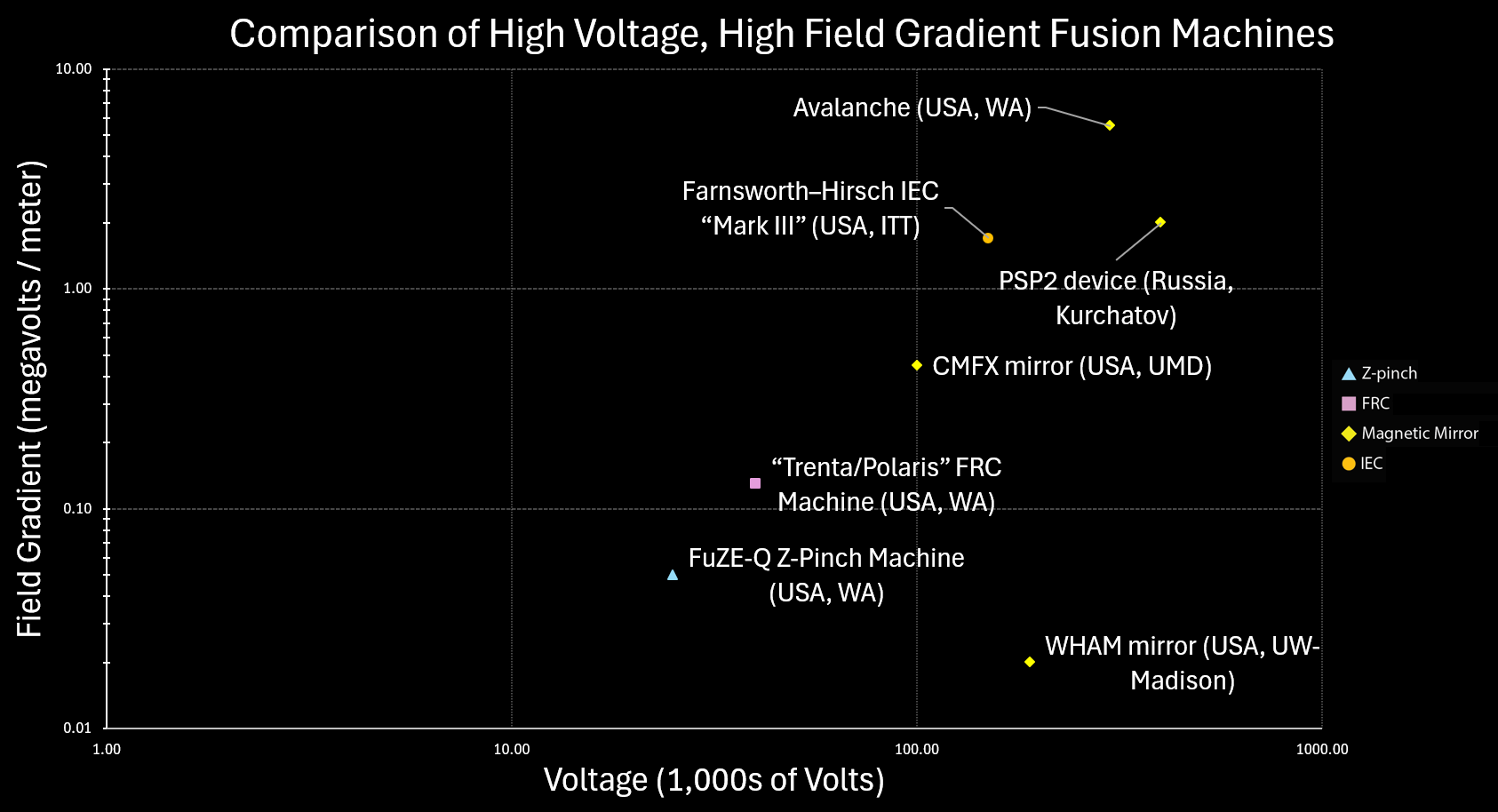News Release
Avalanche Energy Completes Final Series A Voltage Milestone: 300,000 Volts in Compact, High-Efficiency Prototype Fusion Machine
Seattle-based Avalanche Energy has achieved a critical high-voltage milestone in its pursuit of compact fusion: sustaining 300,000 volts across just two and a half inches of space—equating to an average electric field gradient of over 4.7 megavolts per meter (MV/m). That field strength rivals some of the steepest natural voltage gradients on Earth—exceeding even lightning—and does so in steady-state, using just 3 watts of power. It’s a technical achievement rarely seen in fusion systems and a key unlock for Avalanche’s magneto-electrostatic approach. For Avalanche, this isn’t just about reaching high voltage—it’s about holding extreme electric fields in compact geometries with unprecedented efficiency.
“This milestone is a key unlock for our approach to fusion" says Robin Langtry, Co-Founder and CEO of Avalanche Energy. “Maintaining 300,000 volts in steady state across just 2.5 inches, is what we set out to do, but maintaining it with only a few Watts of power demonstrates our approach is on path for high-efficiency- which is a huge win.”
Voltage, commonly referred to as electric potential, measures the difference in electrical energy potential between two points. A useful analogy is lightning: when voltage builds up between a cloud and the ground, it eventually releases as a violent burst of energy. Avalanche is working to contain that kind of energy—not as a brief flash, but as a stable, continuous state. Think of voltage like the height of a mountain—the greater the height, the more potential energy. But the real challenge isn't just how tall the mountain is—it's how steep the climb is, and how little energy it takes to stay up there. For example, Kilimanjaro averages a ~10% gradient, Everest ~17.5%, and K2—a notoriously technical and dangerous peak—averages ~30%. The steeper the gradient, the more technically demanding the climb. Similarly, in fusion devices, the steeper the electric field (measured in megavolts per meter), the tougher the challenge—but also the more performative the machine.
Avalanche just demonstrated 300,000 volts with a 2.5-inch gap—resulting in an electric field gradient of over 4.7 megavolts per meter (MV/m). That’s a steep climb by any standard, and a technical achievement matched by very few in the world.
“Steep field gradients are where the real engineering challenge lies,” said Brian Riordan, Co-Founder and COO. “It’s not just about how much voltage you generate—it’s how tightly you can contain it, and how little power it takes to maintain it. Our system hit over 4.7 megavolts per meter, and drew a minuscule 3 Watts of power- less than a typical nightlight. To our knowledge, this puts us in our own league of extremely high electrostatic field gradient in a compact device.”
High voltage not only helps confine the ions that Avalanche aims to fuse, but also contributes to plasma heating—both essential for efficient fusion reactions. The steeper the electric field gradient, the more energy ions gain over a short distance, leading to better collision rates, and ultimately, more effective fusion.
This high voltage milestone, the last for Series A, is a steady-state; significantly more challenging than pulsed high voltage, which only needs to hold for microseconds or milliseconds and can tolerate brief breakdowns or losses in stability. “300,000 Volts” Says Robin Langtry “is the ideal energy for fusing Deuterium and Tritium in our compact machine.”
To illustrate this achievement in context, Avalanche has plotted the voltage and field gradient of various fusion and high-voltage systems on a log-log scale. The Orbitron stands out distinctly among other systems, achieving a steeper field gradient than many other fusion machines. While many high-voltage devices spread their voltage across large distances, Avalanche’s system concentrates it across just 2.5 inches—resulting in a field gradient of 4.7 MV/m. Though, Avalanche notes that most fusion machines aren't targeting compact fusion like they are- Avalanche leaned into this engineering challenge to unlock compact fusion.
[See the comparison plot: "High Voltage vs Field Gradient"]

Avalanche’s achievement of this critical high-voltage milestone completes the final high-voltage objective in Avalanche Energy’s Series A roadmap and helps improve its position as a leader in compact fusion innovation. By achieving high electric field strength with minimal power draw, Avalanche is proving the foundational physics and engineering behind its Orbitron architecture. The company now is building the next device to further densify the plasma and push into higher neutron generation and efficiency – continuing its mission to deliver compact fusion power.
About Avalanche Fusion
Avalanche Energy is a venture-backed, fusion energy start-up based in Seattle, WA. Avalanche's modular design can be stacked for near-endless power applications and unprecedented energy density to provide clean energy for applications in austere and grid-challenged settings (space propulsion, underwater UAVs, data centers, etc). This unique approach enables rapid iterations of design, build, test, and fix cycles for faster development and scalability. To learn more, visit avalanchefusion.com.

